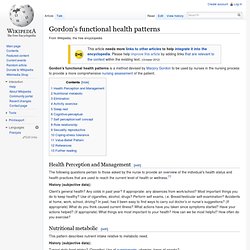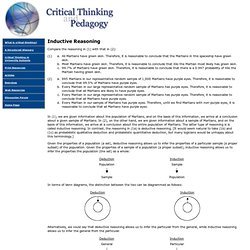

Bias in nursing practice. Gordon's functional health patterns. Gordon's functional health patterns is a method devised by Marjory Gordon to be used by nurses in the nursing process to provide a more comprehensive nursing assessment of the patient.

Health Perception and Management[edit] The following questions pertain to those asked by the nurse to provide an overview of the individual's health status and health practices that are used to reach the current level of health or wellness.[1] History (subjective data): Client’s general health? Any colds in past year? [edit] This pattern describes nutrient intake relative to metabolic need. Typical daily food intake? Typical daily fluid intake? Weight loss/gain? Appetite? Food or eating: Discomfort, swallowing difficulties, diet restrictions, able to follow? Healing – any problems? Skin problems: lesions? Dental problems? Examination (examples of objective data): Skin assessment, oral mucous membranes, teeth, actual weight/height, temperature.
Abdominal assessment. Elimination[edit] Activity exercise[edit] None. Bell7. Critical Thinking and Pedagogy: Inductive Reasoning. Inductive Reasoning Compare the reasoning in (1) with that in (2): In (1), we are given information about the population of Martians, and on the basis of this information, we arrive at a conclusion about a given sample of Martians.

In (2), on the other hand, we are given information about a sample of Martians, and on the basis of this information, we arrive at a conclusion about the entire population of Martians. The latter type of reasoning is is called inductive reasoning. In contrast, the reasoning in (1a) is deductive reasoning. Given the properties of a population (a set), deductive reasoning allows us to infer the properties of a particular sample (a proper subset) of the population. In terms of Venn diagrams, the distinction between the two can be diagrammed as follows: Alternatively, we could say that deductive reasoning allows us to infer the particular from the general, while inductive reasoning allows us to infer the general from the particular.
Conservative induction. Critical Thinking and Pedagogy: Rules of Inference. Rules of Inference The goal of logic is to make explicit our intuitions of good reasoning, such that we can distinguish between good reasoning and bad reasoning in terms of an explicit procedure that does not need to rely on intuitions.

To do this, logicians formulate the information and the inferences involved in reasoning as propositions. As we have seen the propositions of the information from which we derive inferences are called premises, while the propositions of the inferences are called conclusions. How do we distinguish between good reasoning and bad reasoning? Take the following examples: Intuitively, we recognize example 1 to be an instance of good reasoning and example 2 to be an instance of bad reasoning. Let us denote x is a human as P and x is a mammal as Q: We now see that the sentence All humans are mammals expresses a complex proposition consisting of two propositions P and Q, and is of the form: If P, then Q.
We can now express the logical structure of examples 1and 2 as: Creative Thinking Techniques. .

:VirtualSalt Robert Harris Version Date: January 5, 2002 You'll remember the five creative methods we discussed in the Introduction to Creative Thinking: evolution, synthesis, revolution, reapplication, changing direction. Many classic creative thinking techniques make use of one or more of these methods. Note in this section that the goal is to produce a good quantity and a good quality of new ideas and solutions so that the best ones may be chosen. Brainstorming Alex Osborn, advertising writer of the fifties and sixties, has contributed many very powerful creative thinking techniques. Errors in medical thinking, a helpful guide.